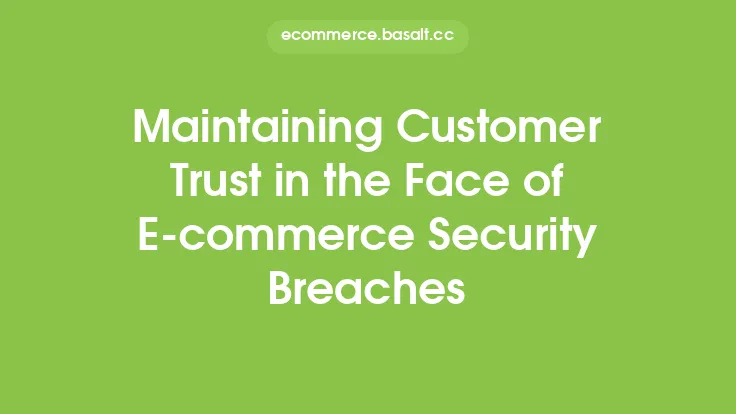In today's digital age, e-commerce has become an integral part of our lives, with millions of people shopping online every day. However, this increased online activity has also led to a rise in cyber threats, making e-commerce security a top priority for online businesses. One crucial aspect of e-commerce security is two-factor authentication (2FA), which adds an extra layer of protection to the traditional username and password combination. In this article, we will delve into the world of two-factor authentication and explore its role in e-commerce security.
What is Two-Factor Authentication?
Two-factor authentication is a security process that requires users to provide two different authentication factors to access a system, network, or application. The first factor is typically a username and password, while the second factor can be a variety of things, such as a code sent to a user's phone, a biometric scan, or a physical token. This additional layer of security makes it much more difficult for hackers to gain unauthorized access to an account, as they would need to have both the username and password, as well as the second factor.
Types of Two-Factor Authentication
There are several types of two-factor authentication, each with its own unique characteristics and advantages. Some of the most common types of 2FA include:
- SMS-based 2FA: This type of 2FA sends a code to a user's phone via SMS, which they must then enter to access the system.
- Authenticator app-based 2FA: This type of 2FA uses a special app, such as Google Authenticator or Authy, to generate a time-based one-time password (TOTP) that users must enter to access the system.
- Biometric 2FA: This type of 2FA uses biometric data, such as fingerprints or facial recognition, to verify a user's identity.
- Physical token-based 2FA: This type of 2FA uses a physical token, such as a USB drive or a smart card, to verify a user's identity.
Benefits of Two-Factor Authentication in E-commerce
The benefits of two-factor authentication in e-commerce are numerous. Some of the most significant advantages include:
- Improved security: 2FA adds an extra layer of protection to the traditional username and password combination, making it much more difficult for hackers to gain unauthorized access to an account.
- Reduced risk of phishing attacks: 2FA makes it much more difficult for hackers to use phishing attacks to gain access to an account, as they would need to have both the username and password, as well as the second factor.
- Increased customer trust: By implementing 2FA, e-commerce businesses can demonstrate their commitment to security and protect their customers' sensitive information, which can help to increase customer trust and loyalty.
- Compliance with regulations: 2FA can help e-commerce businesses to comply with regulations, such as the Payment Card Industry Data Security Standard (PCI DSS), which requires merchants to implement 2FA to protect sensitive payment information.
Implementation of Two-Factor Authentication in E-commerce
Implementing two-factor authentication in e-commerce can be a straightforward process. Some of the steps involved in implementing 2FA include:
- Choosing a 2FA method: E-commerce businesses must choose a 2FA method that is suitable for their needs and budget. Some popular 2FA methods include SMS-based 2FA, authenticator app-based 2FA, and biometric 2FA.
- Integrating 2FA with existing systems: E-commerce businesses must integrate 2FA with their existing systems, such as their website, mobile app, and payment gateway.
- Configuring 2FA settings: E-commerce businesses must configure 2FA settings, such as the type of 2FA method to use, the frequency of 2FA prompts, and the types of transactions that require 2FA.
- Testing 2FA: E-commerce businesses must test 2FA to ensure that it is working correctly and that it is not causing any issues with their systems or customer experience.
Best Practices for Two-Factor Authentication in E-commerce
To get the most out of two-factor authentication, e-commerce businesses should follow best practices, such as:
- Using a combination of 2FA methods: E-commerce businesses should consider using a combination of 2FA methods, such as SMS-based 2FA and authenticator app-based 2FA, to provide an additional layer of security.
- Implementing 2FA for all users: E-commerce businesses should implement 2FA for all users, including customers, employees, and administrators, to ensure that all accounts are protected.
- Providing clear instructions: E-commerce businesses should provide clear instructions to customers on how to use 2FA, including how to set up 2FA and how to troubleshoot common issues.
- Monitoring 2FA activity: E-commerce businesses should monitor 2FA activity to detect and respond to potential security threats, such as suspicious login attempts or 2FA bypass attempts.
Common Challenges and Limitations of Two-Factor Authentication
While two-factor authentication is a powerful security tool, it is not without its challenges and limitations. Some of the common challenges and limitations of 2FA include:
- User resistance: Some customers may resist using 2FA, citing concerns about convenience or complexity.
- Technical issues: 2FA can sometimes cause technical issues, such as login errors or 2FA prompt failures.
- Cost: Implementing 2FA can be costly, especially for small e-commerce businesses or those with limited budgets.
- Limited availability: Some 2FA methods, such as biometric 2FA, may not be available on all devices or platforms.
Future of Two-Factor Authentication in E-commerce
The future of two-factor authentication in e-commerce is likely to be shaped by emerging trends and technologies, such as:
- Artificial intelligence (AI) and machine learning (ML): AI and ML can be used to improve 2FA, such as by using behavioral biometrics to detect and prevent suspicious activity.
- Internet of Things (IoT): The growing use of IoT devices is likely to create new security challenges and opportunities for 2FA.
- Quantum computing: The emergence of quantum computing is likely to create new security challenges and opportunities for 2FA, such as the use of quantum-resistant algorithms.
- Passwordless authentication: Passwordless authentication methods, such as biometric authentication and behavioral authentication, are likely to become more popular in the future, potentially replacing traditional 2FA methods.





